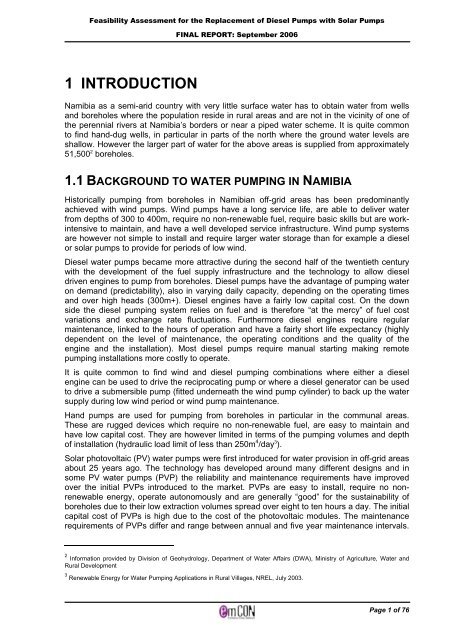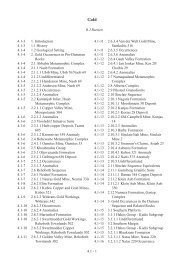Solar PV water pumping study - FINAL REPORT ... - UNDP, Namibia
Solar PV water pumping study - FINAL REPORT ... - UNDP, Namibia
Solar PV water pumping study - FINAL REPORT ... - UNDP, Namibia
Create successful ePaper yourself
Turn your PDF publications into a flip-book with our unique Google optimized e-Paper software.
Feasibility Assessment for the Replacement of Diesel Pumps with <strong>Solar</strong> Pumps<br />
1 INTRODUCTION<br />
<strong>FINAL</strong> <strong>REPORT</strong>: September 2006<br />
<strong>Namibia</strong> as a semi-arid country with very little surface <strong>water</strong> has to obtain <strong>water</strong> from wells<br />
and boreholes where the population reside in rural areas and are not in the vicinity of one of<br />
the perennial rivers at <strong>Namibia</strong>’s borders or near a piped <strong>water</strong> scheme. It is quite common<br />
to find hand-dug wells, in particular in parts of the north where the ground <strong>water</strong> levels are<br />
shallow. However the larger part of <strong>water</strong> for the above areas is supplied from approximately<br />
51,500 2 boreholes.<br />
1.1 BACKGROUND TO WATER PUMPING IN NAMIBIA<br />
Historically <strong>pumping</strong> from boreholes in <strong>Namibia</strong>n off-grid areas has been predominantly<br />
achieved with wind pumps. Wind pumps have a long service life, are able to deliver <strong>water</strong><br />
from depths of 300 to 400m, require no non-renewable fuel, require basic skills but are workintensive<br />
to maintain, and have a well developed service infrastructure. Wind pump systems<br />
are however not simple to install and require larger <strong>water</strong> storage than for example a diesel<br />
or solar pumps to provide for periods of low wind.<br />
Diesel <strong>water</strong> pumps became more attractive during the second half of the twentieth century<br />
with the development of the fuel supply infrastructure and the technology to allow diesel<br />
driven engines to pump from boreholes. Diesel pumps have the advantage of <strong>pumping</strong> <strong>water</strong><br />
on demand (predictability), also in varying daily capacity, depending on the operating times<br />
and over high heads (300m+). Diesel engines have a fairly low capital cost. On the down<br />
side the diesel <strong>pumping</strong> system relies on fuel and is therefore “at the mercy” of fuel cost<br />
variations and exchange rate fluctuations. Furthermore diesel engines require regular<br />
maintenance, linked to the hours of operation and have a fairly short life expectancy (highly<br />
dependent on the level of maintenance, the operating conditions and the quality of the<br />
engine and the installation). Most diesel pumps require manual starting making remote<br />
<strong>pumping</strong> installations more costly to operate.<br />
It is quite common to find wind and diesel <strong>pumping</strong> combinations where either a diesel<br />
engine can be used to drive the reciprocating pump or where a diesel generator can be used<br />
to drive a submersible pump (fitted underneath the wind pump cylinder) to back up the <strong>water</strong><br />
supply during low wind period or wind pump maintenance.<br />
Hand pumps are used for <strong>pumping</strong> from boreholes in particular in the communal areas.<br />
These are rugged devices which require no non-renewable fuel, are easy to maintain and<br />
have low capital cost. They are however limited in terms of the <strong>pumping</strong> volumes and depth<br />
of installation (hydraulic load limit of less than 250m 4 /day 3 ).<br />
<strong>Solar</strong> photovoltaic (<strong>PV</strong>) <strong>water</strong> pumps were first introduced for <strong>water</strong> provision in off-grid areas<br />
about 25 years ago. The technology has developed around many different designs and in<br />
some <strong>PV</strong> <strong>water</strong> pumps (<strong>PV</strong>P) the reliability and maintenance requirements have improved<br />
over the initial <strong>PV</strong>Ps introduced to the market. <strong>PV</strong>Ps are easy to install, require no nonrenewable<br />
energy, operate autonomously and are generally “good” for the sustainability of<br />
boreholes due to their low extraction volumes spread over eight to ten hours a day. The initial<br />
capital cost of <strong>PV</strong>Ps is high due to the cost of the photovoltaic modules. The maintenance<br />
requirements of <strong>PV</strong>Ps differ and range between annual and five year maintenance intervals.<br />
2 Information provided by Division of Geohydrology, Department of Water Affairs (DWA), Ministry of Agriculture, Water and<br />
Rural Development<br />
3 Renewable Energy for Water Pumping Applications in Rural Villages, NREL, July 2003.<br />
Page 1 of 76




